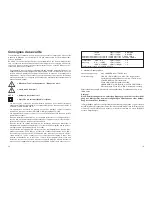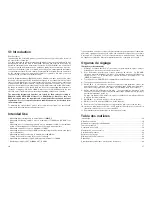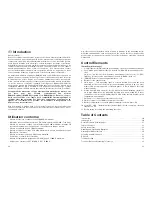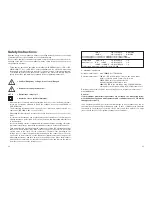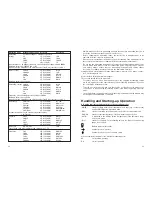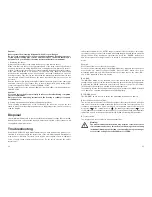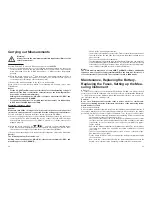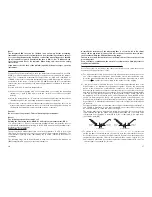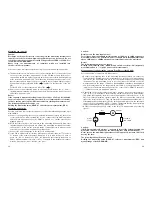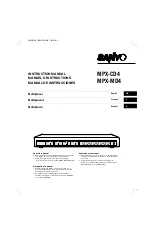
32
Caution!
Never operate the measuring instrument when it is open! Danger!
Do not leave used batteries in the measuring instrument. Even batteries pro-
tected against leaking may corrode and thus release chemicals that may be
detrimental to your health or they may destroy the battery compartment.
c Replacing the fuses
Always adhere carefully to the safety instructions, if you replace fuses!
Make sure that only fuses of the type stated and of the rated current specified are
used as a replacement. Using repaired fuses or bridging the fuse bracket is not per-
mitted. To replace the fuses disconnect the measuring instrument from the measure-
ment circuit and switch it off. Remove all connected lines, adapters and testing
prods from the measuring device. Use a suitable crosshead screwdriver to open the
housing carefully. First, remove the cover with the battery and then unscrew the last
two recessed head screws. Remove the lower cover part; now the fuses can be
accessed.
Remove the defective fuse(s) and replace it (them) by a fuse (fuses) of the same type
and rated current. For the ceramic fuse of the mA-range: 0.5A quick-acting, 250V;
common designation: F 0.5A / 250V or F500mA / 250V
For the ceramic fuse of the A-range: 10A, quick-acting, 250V; common designation:
10A LAC 250V.
Caution!
Close and fasten the hosing carefully in reverse order after having completed
the fuse replacement.
Only operate the measuring instrument if the housing is reliably closed and
screwed down.
d Setting up the measuring instrument (diagonal position)
The measuring instrument has a fold-out stand on the rear side. You can use this
stand to move the measuring instrument into a diagonal position; thus it is easier to
read the display.
Disposal
If the digital multimeter fails to function with the proper supply voltage (9V compound
battery) and fuses or it cannot be repaired, it must be disposed of in accordance with
the applicable legal provisions.
Troubleshooting
With this VC-820 or VC-840 digital multimeter, you have purchased a product con-
structed in accordance with the latest state of the art. Problems and disturbances
may, however, still arise. Therefore, there follows a description of how to eliminate
some of these faults relatively easily yourself. Do not fail to observe the safety
instructions!
25
ratio measurements. As the „AUTO“ range is turned off for the reference value mea-
surement, you have to select the desired measuring range manually before using this
special function. After leaving this extra function, press the „RANGE“ button once
and keep it pressed for longer than 1s to return to the automatic range selection
mode.
Example:
Proceed as follows to set the reference value:
Set the desired measuring range (via the RANGE button). Measure the required ref-
erence value, e.g. a direct voltage of 12VDC. Press the “REL” button once. If the
measuring prods are now disconnected from the voltage source, the value „DC -
12V“ will be indicated in the main display.
B 4 HOLD
The „HOLD H“ button is to be activated once, if you want to keep a test certificate for
example and want to record the current measuring value before it will change again.
By pressing the „HOLD“ button the current value is „frozen“ or kept. The „H“ symbol
in the header of the display is marked by a black background.
If you want to release the running measurement anew, activate the „HOLD H“ button
once again. The currently measured value will be displayed.
B 5 POWER (round)
The „POWER“ switch is used to switch the measuring instrument on and off.
B 6 second-function button (blue)
The second-function button is positioned top right of the rotary switch and is used to
turn on/off the blue-described measuring functions around the rotary switch. For
resistance measurements (ohm), each push on the button switches between the
diode test „
“, the continuity check „
“, the capacity measurement „
“ (only
for VC-840) and the resistance measurement. For current and voltage measurements
this button is used to change between direct (DC) and alternating (AC) quantities.
B 7 rotary switch
The rotary switch sets the diverse measuring functions.
Warning!
The measurement function switch may never be reset in the course
of measurement, because this action could damage the measuring
instrument (breaking sparks) and consequently cause grave danger
for you if the voltages exceed 25VACrms or 35VDC.









